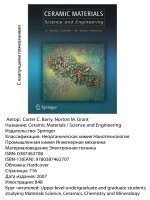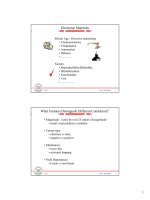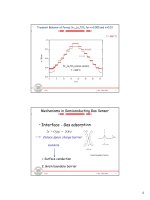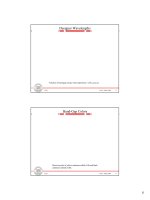English for materials science and engineering
Bạn đang xem bản rút gọn của tài liệu. Xem và tải ngay bản đầy đủ của tài liệu tại đây (1.62 MB, 118 trang )
Iris Eisenbach
English for Materials Science and Engineering
Iris Eisenbach
English for
Materials Science
and Engineering
Exercises, Grammar, Case Studies
Bibliographic information published by the Deutsche Nationalbibliothek
The Deutsche Nationalbibliothek lists this publication in the Deutsche Nationalbibliografie;
detailed bibliographic data are available in the Internet at .
Iris Eisenbach has extensive experience in teaching all levels of English to speakers of other languages and for a wide range of educational and professional purposes. The author graduated in English
and French from the University of Mainz and from the Teacher Training College (Studienseminar)
in Wiesbaden, (both Germany) with the Second State Examination. After teaching foreign languages
to students at different levels for some years, she got tenure as a civil servant (Oberstudienrätin). Iris
Eisenbach has spent the past 20 years concentrating on teaching English to students in university
settings. Presently she is working as a university language instructor at the English and German
Departments of the Language Center of the University of Stuttgart, Germany.
1st Edition 2011
All rights reserved
© Vieweg+Teubner Verlag | Springer Fachmedien Wiesbaden GmbH 2011
Editorial Office: Imke Zander | Thomas Zipsner
Vieweg+Teubner Verlag is a brand of Springer Fachmedien.
Springer Fachmedien is part of Springer Science+Business Media.
www.viewegteubner.de
No part of this publication may be reproduced, stored in a retrieval system or transmitted, in any form or by any means, electronic, mechanical, photocopying, recording, or otherwise, without the prior written permission of the copyright holder.
Registered and/or industrial names, trade names, trade descriptions etc. cited in this publication are
part of the law for trade-mark protection and may not be used free in any form or by any means even
if this is not specifically marked.
Cover design: KünkelLopka Medienentwicklung, Heidelberg
Layout: Stefan Kreickenbaum, Wiesbaden
Pictures: Graphik & Text Studio, Dr. Wolfgang Zettlmeier, Barbing; Stefan Kreickenbaum, Wiesbaden
Printed on acid-free paper
Printed in Germany
ISBN 978-3-8348-0957-5
V
Introduction
This textbook is intended for students of materials science, of different branches of engineering and of related disciplines who need to re-activate their English language skills. Using authentic materials and figures selected from scientific texts, students will improve their reading,
writing and speaking skills in a context relevant to their specialist studies. This work does not
attempt to teach the subject of materials science.
In addition to covering linguistic features specific to scientific and technical purposes, this
book also presents review and practice activities in common problem areas of general English
usage. The material for the textbook has been developed and tested in classes at the English
Department of the University of Stuttgart over several semesters, and it addresses most of the
problems English-language learners confront.
Students’ feedback has been incorporated into the textbook; the author gratefully acknowledges these contributions, which make the book useful for successful teaching and self-study purposes.
Since the book is designed as both textbook and workbook, it is suitable for classroom use and
for self-study. It contains extensive monolingual glossaries, tasks, grammar reviews and word
studies directly related to the texts and figures. Solutions are offered in the back of the book.
The textbook offers sufficient material for a one-semester language class of about 14 sessions.
Subjects, grammar reviews and word studies can also be studied independently.
Acknowledgements
This book would never have been written without the support of the Materials Research Laboratory (MRL) of the University of California, Santa Barbara, where I was accompanying my
husband, Professor Claus D. Eisenbach, in 2007–2008. I am very grateful to the MRL for
kindly offering me the use of the visiting scholar’s office and for providing equipment and
support.
The MRL also made it possible for me to attend classes by two excellent researchers and dedicated teachers, Professor Ram Seshadri and Professor Susanne Stemmer. Professor Seshadri in
particular introduced me to the field of materials science and directed me to my most valuable
source, Materials Science and Engineering: An Introduction, by William D. Callister Jr.
I am also indebted to my husband who was a constant source of knowledge and expertise and
who read and commented on the manuscript. Special thanks to my good friend Pamela Lavigne, whose experience in TESOL (Teaching English to Speakers of Other Languages) and in
editing were of great help. I am likewise grateful to the editors of “Lektorat Maschinenbau” at
Vieweg+Teubner for their technical assistance.
Stuttgart, Autumn 2010
Iris Eisenbach
VII
Table of contents
Chapter 1 Introduction ....................................................................................................
1.1 Historical Background .........................................................................................
1.2 Grammar: Simple Past versus Present Perfect .....................................................
1.3 Materials Science versus Materials Engineering .................................................
1.4 Selection of Materials ..........................................................................................
1.5 Some Phrases for Academic Presentations ..........................................................
1.6 Case Study: The Turbofan Aero Engine ..............................................................
1.7 Some Abbreviations for Academic Purposes ......................................................
1
1
3
5
6
7
8
10
Chapter 2 Characteristics of Materials ..........................................................................
2.1 Structure ..............................................................................................................
2.2 Some Phrases for Academic Writing ...................................................................
2.3 Case Study: The Gecko .......................................................................................
2.4 Property ...............................................................................................................
2.5 Some Phrases for Describing Figures, Diagrams and for Reading Formulas ......
2.6 Grammar: Comparison ........................................................................................
2.7 Processing and Performance ................................................................................
2.8 Classification of Materials ...................................................................................
2.9 Grammar: Verbs, Adjectives, and Nouns followed by Prepositions ...................
12
12
13
15
16
19
20
21
23
24
Chapter 3 Metals ..............................................................................................................
3.1 Introduction .........................................................................................................
3.2 Mechanical Properties of Metals .........................................................................
3.3 Important Properties for Manufacturing ..............................................................
3.4 Metal Alloys ........................................................................................................
3.5 Case Study: Euro Coins .......................................................................................
3.6 Grammar: Adverbs I ............................................................................................
3.7 Case Study: The Titanic ......................................................................................
3.8 Grammar: The Passive Voice ..............................................................................
3.9 Case Study: The Steel-Making Process ...............................................................
25
25
27
29
30
32
34
35
36
38
Chapter 4 Ceramics .........................................................................................................
4.1 Introduction .........................................................................................................
4.2 Structure of Ceramics ..........................................................................................
4.3 Word Formation: Suffixes in Verbs, Nouns and Adjectives ...............................
4.4 Properties of Ceramics .........................................................................................
4.5 Case Study: Optical Fibers versus Copper Cables ...............................................
4.6 Grammar: Adverbs II ...........................................................................................
4.7 Case Study: Pyrocerams ......................................................................................
4.8 Case Study: Spheres Transporting Vaccines .......................................................
4.9 Useful Expressions for Shapes and Solids ..........................................................
40
40
41
41
43
44
46
46
48
49
VIII
Table of contents
Chapter 5 Polymers ..........................................................................................................
5.1 Introduction .........................................................................................................
5.2 Word Formation: The Suffix -able/-ible ..............................................................
5.3 Properties of Polymers .........................................................................................
5.4 Case Study: Common Objects Made of Polymers ...............................................
5.5 Case Study: Ubiquitous Plastics ..........................................................................
5.6 Grammar: Reported Speech (Indirect Speech) ....................................................
5.7 Polymer Processing .............................................................................................
5.8 Case Study: Different Containers for Carbonated Beverages ..............................
51
51
52
53
54
55
57
59
61
Chapter 6 Composites ......................................................................................................
6.1 Introduction .........................................................................................................
6.2 Case Study: Snow Ski ..........................................................................................
6.3 Grammar: Gerund (-ing Form) ............................................................................
6.4 Case Study: Carbon Fiber Reinforced Polymer (CFRP) .....................................
6.5 Word Formation: Prefixes ...................................................................................
63
63
64
66
69
70
Chapter 7 Advanced Materials .......................................................................................
7.1 Introduction .........................................................................................................
7.2 Semiconductors ....................................................................................................
7.3 Case Study: Integrated Circuits ...........................................................................
7.4 Grammar: Subordinate Clauses ...........................................................................
7.5 Smart Materials ....................................................................................................
7.6 Nanotechnology ...................................................................................................
7.7 Case Study: Carbon Nanotubes ...........................................................................
7.8 Grammar: Modal Auxiliaries ...............................................................................
73
73
75
76
77
78
80
80
82
KEY ....................................................................................................................................
84
Credits/Selected Reference List ........................................................................................ 104
Glossary .............................................................................................................................. 106
1
Chapter 1 Introduction
Structure
Properties
Processing
Performance
Figure 1: Materials science tetrahedron [wikipedia]
1.1 Historical Background
Task 1. Work with a partner. Fill the gaps in the text with words from the box in their correct
form.
alloy; characteristic; communication; clay; crystal; heat; housing; manipulate; metal; pottery; property (2); skin; specimen; substance; structure; technological; wood
Materials used in food, clothing,
……………………….………………………..
……………………….………………………….
, transportation, recreation and
influence virtually every segment of our everyday lives.
Historically, materials have played a major role in the development of societies, whose
advancement depended on their access to materials and on their ability to produce and
……………………….……………………..….
them. In fact, historians named civilizations by the level of
their materials development, e.g. the Stone Age (beginning around 2.5 million BC), the Bronze
Age (3500 BC), and the Iron Age (1000 BC). The earliest humans had access to only a very
limited number of materials, those that occur naturally, e.g.
……………………….……………………….
and
…………………………………………….….
…………………………………………….….
,
. With time they discovered tech-
niques for producing materials that had properties superior to those of the natural ones; these
new materials included
………………………………………….…….
and various
………………………………….…………….
.
Furthermore, early humans discovered that the properties of a material could be altered
I. Eisenbach, English for Materials Science and Engineering, DOI 10.1007/978-3-8348-9955-2_1,
© Vieweg+Teubner Verlag | Springer Fachmedien Wiesbaden GmbH 2011
2
by
Chapter 1 Introduction
……………………………………….……….
……………………………………….……….
treatments, e.g. to soften metals, and by adding other
to produce a new material, e.g. by melting copper, then mixing it
with tin to form bronze which could be regarded as the first ………………………………….……………..
Until recently, selecting a material involved choosing from a number of familiar materials the
one most appropriate for the intended application by virtue of its characteristics but without
knowing much about its structure. Only in the 19th century did scientists begin to understand
the
relationships
between
the
structural
elements
of
materials
and
their
. In 1864 the Englishman Henry Sorby first showed the microstruc-
……………………………………….……….
ture of a metal when he developed a technique for etching the surface layer of a polished metal
……………………………….……………….
by a chemical reaction. He used a light reflecting microscope to
show that the material consisted of small
…………………………………….………….
which reflected the light
in different ways because they were oriented in different directions. The crystals were well
fitted together and joined along grain boundaries.
Modern techniques such as x-ray diffraction, transmittance electron microscopy (TEM)
and scanning electron microscopy (SEM) make possible to see further into the
……………………………………….……….
characteristics
and
of materials, which leads to a better understanding of their
promotes
intentional
alteration
and
improvement
of
their
. By now more than 50,000 materials with specialized
………………………………….…………….
…………………………………….………….
have been developed and are available to the engineer, who has to
choose the one best suited to serve the given purpose. Since much of what can be done
……………………………………….……….
is limited by the available materials, engineers must constantly
develop new materials with improved properties.
(from Callister, modified and abridged)
Glossary
to etch
to cut into a surface, e.g. glass, using an acid
acid
a chemical, usually a sour liquid, that contains hydrogen with a pH of less than 7
grain boundary
a line separating differently oriented crystals in a polycrystal
1.2 Grammar: Simple Past versus Present Perfect
3
Task 2. Different verbs in English can be used to describe the action of changing, such as
adjust; alter; change; modify; transform; vary. Refer to a dictionary or thesaurus,
then list the differences in usage and meaning.
………………………………………………………………………..……………………………………………………………………………………….………
………………………………………………………………………..……………………………………………………………………………………………….
………………………………………………………………………..………………………………………………………………………………………….……
………………………………………………………………………..…………………………………………………………………………………………….…
………………………………………………………………………..………………………………………………………………………………………….……
………………………………………………………………………..………………………………………………………………………………………….……
………………………………………………………………………..………………………………………………………………………………………….……
Task 3. Give a short explanation for x-ray diffraction, TEM and SEM.
………………………………………………………………………..……………………………………………………………………………………….………
………………………………………………………………………..…………………………………………………………………………………….…………
………………………………………………………………………..………………………………………………………………………………………….……
………………………………………………………………………..………………………………………………………………………………………….……
………………………………………………………………………..……………………………………………………………………………………….………
1.2 Grammar: Simple Past versus Present Perfect
Scientific and technical texts in English frequently use the present tense, since in most cases
they state facts. Sometimes, the present perfect and simple past have to be used, as the text
about the historical development of materials science shows.
Formation of the Simple Past
Use the so-called second form of the verb
write – wrote – written
She wrote the second proposal last month.
Formation of the Present Perfect
Use have/has + the third form of the verb (the past participle).
write – wrote – written
She has just written the second proposal.
4
Chapter 1 Introduction
Use of the Simple Past
Use the simple past for actions in the past that have no connection to the present and when
the time of the past action is important or shown.
Signal words are yesterday, last Thursday, two weeks ago, in November 1989
Use of the Present Perfect
Use the present perfect for actions in the past with a connection to the present and when the
time of the past actions is not important.
Use the present perfect for recently completed actions and actions beginning in the past and
continuing in the present.
Signal words are: just, never, ever, yet, already, recently, since, for, so far, up to now
Task 1. Work in a group. Revise English irregular verbs, by using a table, e.g. from a dictionary or English grammar book. Take turns eliciting the correct forms from members
of your group.
Task 2. Work with a partner. Fill the gaps in the sentences with the verbs in their correct
tense (present perfect or simple past).
Materials …………………………………………... (always play) a major role in the development of societies.
Civilizations ……………………………………….. (designate) by the level of their materials development.
The earliest humans
………………………………………..
(have) access to only a very limited number of
materials.
The microstructure of a metal
…………………………….………………..
(be) first revealed in 1864 by the
Englishman Henry Sorby who
………………………………………………..
(develop) a technique for etching
the surface layer of a polished metal.
Modern techniques such as x-ray diffraction, transmission electron microscopy (TEM) and
scanning electron microscopy (SEM)
…………………………………………………..…..
(make) it possible to
better understand their characteristics.
By now, more than 50,000 materials ………………………………………..…………….. (develop).
Materials scientists ………………………………………………….. (long envy) the resilience of certain naturally
occurring materials.
Past efforts to reproduce the architecture of, e.g. a shell
successful).
……………………………………………..
(not be
1.3 Materials Science versus Materials Engineering
To copy the microstructure of the shell, the researchers
5
………………………………………………………..
(mix)
water with finely ground ceramic powder and polymer binders.
Glossary
resilience, n
resilient, adj
elasticity; property of a material to resume its original shape/position after being
bent/stretched/compressed
binder
a polymeric material used as matrix in which particles are evenly distributed
matrix
a substance in which another substance is contained
n = noun
adj = adjective
v = verb
1.3 Materials Science versus Materials Engineering
The discipline of materials science and engineering includes two main tasks.
Materials scientists examine the structure-properties relationships of materials and develop or
synthesize new materials.
Materials engineers design the structure of a material to produce a predetermined set of properties on the basis of structure-property relationships. They create new products or systems
using existing materials and/or develop techniques for processing materials.
Most graduates in materials programs are trained to be both materials scientists and materials
engineers.
(from Callister, modified and abridged)
Glossary
to synthesize,
synthesis, n
to produce a substance by chemical or biological reactions
predetermined
decided beforehand
Task 1. Read the text above. Then decide whether the statements are true or false.
Rewrite the false statements if necessary.
Materials scientists do research on finished materials.
………………………………………………………………………..………………………………………………………………………………………………
New products are based on new materials only.
………………………………………………………………………..………………………………………………………………………………………………
Materials science can be subdivided because different approaches to materials are employed.
………………………………………………………………………..………………………………………………………………………………………………
Materials engineers investigate the correlation between structure and property.
………………………………………………………………………..………………………………………………………………………………………………
6
Chapter 1 Introduction
1.4 Selection of Materials
Selecting the right material from the many thousands that are available poses a serious problem. The decision can be based on several criteria. The in-service conditions must be characterized, for these will dictate the properties required of the material. A material does not always
have the maximum or ideal combination of properties. Thus, it may be necessary to trade off
one characteristic for another.
The classic example includes strength and ductility. Normally, a material having a high
strength will have only a limited ductility. A second selection consideration is any deterioration of material properties that may occur during service operation.
For example, significant reductions in mechanical strength may result from exposure to elevated temperatures or corrosive environments. If a compromise concerning desired in-service
properties cannot be reached, new materials have to be developed.
Probably the most important consideration is that of economics. A material may be found that
has the ideal set of properties but is extremely expensive. Some compromise is inevitable. The
cost of a finished piece also includes any cost occurring during fabrication to produce the desired shape. For example: commodity plastics like polyethylene or polypropylene cost about
$ 0.50/lb, whereas engineering resins or Nylon cost $ 1,000/lb.
(from Callister, modified and abridged)
Glossary
strength
the power to resist stress or strain; the maximum load, i.e. the applied force, a
ductile material can withstand without permanent deformation
ductility, n
ductile, adj
a material’s ability to suffer measurable plastic deformation before fracture
plastic deformation
a non-reversible type of deformation, i.e. the material will not return to its original shape
corrosive, n, adj
to corrode, corrosion
a corroding substance, e.g. an acid
commodity
article of trade
lb
pound, 453.592 grams
resin
a natural substance, e.g. amber, or a synthetic compound, which begins in a
highly viscous state and hardens when treated
compound
a pure, macroscopically homogeneous substance consisting of atoms/ions of
two/more different elements that cannot be separated by physical means
viscous, adj
viscosity, n
having a relatively high resistance to flow
Task 1. Explain the grammatical use of the term prohibitively in the sentence below.
A material may be found that has the ideal set of properties but is prohibitively expensive.
………………………………………………………………………..………………………………………………………………………………………………
1.5 Some Phrases for Academic Presentations
7
Task 2. Write short answers to the questions.
What are necessary steps when considering a material for a certain application?
………………………………………………………………………..………………………………………………………………………………………………
………………………………………………………………………..………………………………………………………………………………………………
………………………………………………………………………..………………………………………………………………………………………………
………………………………………………………………………..………………………………………………………………………………………………
Which trade-offs are unavoidable when choosing a particular material?
………………………………………………………………………..………………………………………………………………………………………………
………………………………………………………………………..………………………………………………………………………………………………
………………………………………………………………………..………………………………………………………………………………………………
………………………………………………………………………..………………………………………………………………………………………………
1.5 Some Phrases for Academic Presentations
Introduction (after greeting the audience and introducing yourself or being introduced)
The subject/topic of my presentation today will be …
Today I would like to present recent result of our research on …
What I want to focus on today is …
Outlining the structure of the presentation
I will address the following three aspects of …
My presentation will be organized as can be seen from the following slide.
I will start with a study of … . Next, important discoveries in the field of … will be introduced.
Finally, recent findings of … will be discussed.
Introducing a new point or section
Having discussed …, I will now turn to …
Let’s now address another aspect.
Referring to visual aids
As can be seen from the next slide/diagram/table …
This graph shows the dependency of … versus …
The following table gives typical values of …
In this graph we have plotted … with …
8
Chapter 1 Introduction
Concluding/summarizing
Wrapping up …
To summarize/sum up/conclude …
Inviting questions
Please don’t hesitate to interrupt my talk when questions occur.
I’d like to thank you for your attention.
I’ll be happy/pleased to answer questions now.
Dealing with questions
I cannot answer this question right now, but I’ll check and get back to you.
Perhaps this question can be answered by again referring to/looking at table …
1.6 Case Study: The Turbofan Aero Engine
Figure 2: Cross-section of a turbofan aero engine [wikipedia]
Task 1. Work with a partner. Study the following notes. Then refer to 1.5 Phrases for Academic Presentation and give a short presentation about the subject.
In the turbofan aero engine, which is used to power large planes, air is propelled past and into
the engine by the turbofan, providing aerodynamic thrust. The air is further compressed by
compressor blades, then mixed with fuel and burnt in the combustion chamber. The expanding
gases drive the turbine blades, which provide power to the turbofan and the compressor blades,
and finally pass out of the rear of the engine, adding to the thrust.
1.6 Case Study: The Turbofan Aero Engine
9
Two kinds of materials were considered:
Metal, a titanium alloy
material’s properties and in-service requirements:
Young’s Modulus, yield strength, fracture toughness sufficiently good
high density (the heavier the engine, the less payload can be carried)
resistance to fatigue (due to rapidly varying loads)
resistance to surface wear (striking water drops, large birds)
resistance to corrosion (salt sprays from ocean entering the engine)
Composite, carbon-fiber reinforced polymer (CFRP)
material’s properties and in-service requirements:
low density (half of that of titanium)
low weight
low toughness (potential deformation of blade by bird strike)
The problem posed by choosing CFRP for a blade can be overcome by cladding, which means
giving the CFRP a metallic leading edge.
(from Ashby/Jones, modified and abridged)
Glossary
thrust
a forward directed force
combustion
the process of burning; here of fuel
alloy
a metallic substance that is composed of two or more elements which keep the same
crystal structure in the alloy
Young’s Modulus
elastic modulus (E), a material’s property that relates strain (İ, epsilon) to applied
stress (ı, sigma)
strain
the response of a material when tensile stress is applied
tensile stress
a force tending to tear a material apart
stress, n
the force applied to a material per unit area; (ı, sigma = F/A or lb/in²)
in
inch, 2.54 cm
yield strength
the point at which a material starts to deform permanently
fracture toughness
the measure of a material’s resistance to fracture when a crack occurs
crack, n, v
a break, fissure on a surface
density
mass per volume
fatigue
the weakening/failure of a material resulting from prolonged stress
10
Chapter 1 Introduction
1.7 Some Abbreviations for Academic Purposes
Task 1. Add your notes in the column on the right.
AC
alternating current
approx., ca.
approximate(ly)
AT
air temperature
at. no.
atomic number
at. wt.
atomic weight
avg.
average
b.p.
boiling point
c., cu., cub.
cubic
cath.
cathode
cc
cubic centimetre(s)
cf. (conferre)
confer, compare
C. of C.
coefficient of correlation
co.
column
cont(d).
continue(d), contain(ed)
ctr.
center
DC
direct current
Dept.
department
dup.
duplicate
e.g. (exempli gratia)
for example
esp.
especially
est(d).
estimated
etc. (et cetera)
and so on
ex.
example
f., ft.
foot, feet, frequency
hor.
horizontal
i.e. (id est)
that is
in., ins.
inch(es)
1.7 Some Abbreviations for Academic Purposes
incl.
including, included, inclusive
kWh
kilowatt-hour(s)
l., ll.
long, length, line, lines
liq.
liquid
max., min.
maximum, minimum
mech.
mechanical
misc.
miscellaneous
mol wt.
molecular weight
m.p.
melting point
n.a.
not applicable
NB, nb (nota bene)
note particularly
No., no.
number
ord.
ordinary, ordinal
oz(s).
ounce(s)
par.
parallel
prev.
previous
pt.
part
qt.
quantity, quart
resp.
respectively
rpm
revolutions per minute
stat.
statistics
std.
standard
syn.
synthetic
tech.
technical(ly)
vel.
velocity
vs.
versus
w/
with
w/o
without
yd(s).
yard(s)
11
12
Chapter 2 Characteristics of Materials
2.1 Structure
The structure of a material is usually determined by the arrangement of its internal components. On an atomic level, structure includes the organization of atoms relative to one another.
Subatomic structure involves electrons within individual atoms and interactions with their
nuclei. Some of the important properties of solid materials depend on geometrical atomic arrangements as well as on the interactions that exist among atoms or molecules.
Various types of primary and secondary interatomic bonds hold together the atoms composing
a solid.
The next larger structural area is of nanoscopic scale which comprises molecules formed by
the bonding of atoms, and particles or structures formed by atomic or molecular organisation,
all within 1 nm – 100 nm dimensions. Beyond nano scale are structures called microscopic,
meaning that they can directly be observed using some kind of microscope. Finally, structural
elements that may be viewed with the naked eye are called macroscopic.
(from Callister, modified and abridged)
Glossary
nm
nanometer (10-9 m)
Task 1. Work with a partner. Fill in the table with the different structural levels and their
characteristics as described in the text.
structural level
characteristics
I. Eisenbach, English for Materials Science and Engineering, DOI 10.1007/978-3-8348-9955-2_2,
© Vieweg+Teubner Verlag | Springer Fachmedien Wiesbaden GmbH 2011
2.2 Some Phrases for Academic Writing
13
Task 2. Choose the correct terms for the following definitions.
A sufficiently stable, electrically neutral group of at least two units in a definite arrangement
held together by strong chemical bonds. .……………………………………………..
The smallest particle characterizing an element .……………………………………………..
A fundamental subatomic particle, carrying a negative electric charge. .…………………………………………
It makes up almost all the mass of an atom. .……………………………………………..
A positively charged subatomic particle. .……………………………………………..
An electrically neutral subatomic particle. .……………………………………………..
2.2 Some Phrases for Academic Writing
Introduction
In this paper/project/article we will focus on …
In our study, we have investigated …
Our primary objective is …
Making a generalization
It is well known that …
It is generally accepted that …
Making a precise statement
In particular
Particularly/especially/mainly/ more specifically
Quoting
According to/referring to …
As has been reported in … by …
Referring to earlier work of …
Introducing an example
e.g. …
if … is considered for example
14
Chapter 2 Characteristics of Materials
Interpreting
The data could be interpreted in the following way …
These data infer that …
This points to the fact that …
Referring to data
As is shown in the table/chart/data/diagram/graph/plot/figure
Adding aspects
Furthermore our data show …
In addition … has to be considered
Expressing certainty
It is clear/obvious/certain/noticeable that …
An unequivocal result is that …
Expressing uncertainty
It is not yet clear whether …
However it is still uncertain/open if …
Emphasizing
It has to be emphasized/stressed that …
Summarizing
Our investigation has shown that …
To summarize/sum up our results …
Concluding
We come to the conclusion that …
Our further work will focus on …
Further studies/research on … will still be needed.
Detailed insights into … are still missing.
2.3 Case Study: The Gecko
15
2.3 Case Study: The Gecko
Figure 3: The underside of a gecko and its feet [adapted from Seshadri]
Task 1. Work with a partner. Fill the gaps in the text with words from the box in their correct
form. Some terms are used more than once.
adhesion; adhesive; design; horizontal; mass; microscopic; molecule; release; residue; selfcleaning; sticky; surface; underside; vertical
The photograph shows the
……………………………….……….
of a gecko, a harmless tropical lizard, and
its toes. Researchers worldwide are studying the animal’s adhesive system. The scientists want
to learn from nature how to
……………………………….……….
dry adhesives such as geckos apply when
moving their feet over smooth surfaces. The animals achieve high adhesion and friction forces
required for rapid
underside of
……………………………….……….
……………………………….……….
(running up walls) and inverted (running along the
surfaces) motion, since their
……………………………….……….
feet
will cling to virtually any surface. Yet they can easily and quickly release the sticky pads under
their toes to make the next step. A gecko can support its body
single toe, because it has an extremely large number of
……………………………….……….
……………………………….……….
with a
small ordered
fiber bundles on each toe pad. When these fibrous structures come in contact with a surface,
weak forces of attraction, i.e. van der Waals forces, are established between hair
……………………………….……….
and molecules on the surface. The fact that these fibers are so small
and so numerous explains why the animal grips
……………………………….……….
……………………………….……….
so tightly. To
its grip, the gecko simply curls up its toes and peels the fibers away
16
Chapter 2 Characteristics of Materials
from the surface. Another fascinating feature of gecko toe pads is that they are
……………………………….……….
that is, dirt particles don’t stick to them. Scientists are just beginning to
understand the mechanism of
the development of
……………………………….……….
……………………………….……….
for these tiny fibers, which may lead to
self-cleaning synthetics. Imagine duct tape that
never looses its stickiness or bandages that never leave a sticky ……………………………….………..
(from Callister, modified and abridged)
Glossary
adhesive n, adj,
to adhere, adhesion, n
a substance used for joining surfaces together, sticky
release, v, n
to let go
residue
the remainder of sth after removing a part
toe pad
a cushion-like flesh on the underside of animals’ toes and feet
duct tape
an adhesive tape for sealing heating and air-conditioning ducts
2.4 Property
While in use, all materials are exposed to external stimuli that cause some kind of response. A
property is a material characteristic that describes the kind and magnitude of response to a
specific stimulus. For example, a specimen exposed to forces will experience deformation, or a
metal surface that has been polished will reflect light. In general, definitions of property are
made independent of material shape and size.
Virtually all important properties of solid materials may be grouped into six different categories:
–
–
–
–
–
–
mechanical
electrical
thermal (including melting and glass transition temperatures)
magnetic
optical
deteriorative
(from Callister, modified and abridged)
Glossary
glass transition temperature Tg
the temperature at which, upon cooling, a non-crystalline ceramic
transforms from a supercooled liquid to a solid glass
supercooled
cooled to below a phase transition temperature without the
occurrence of transformation









